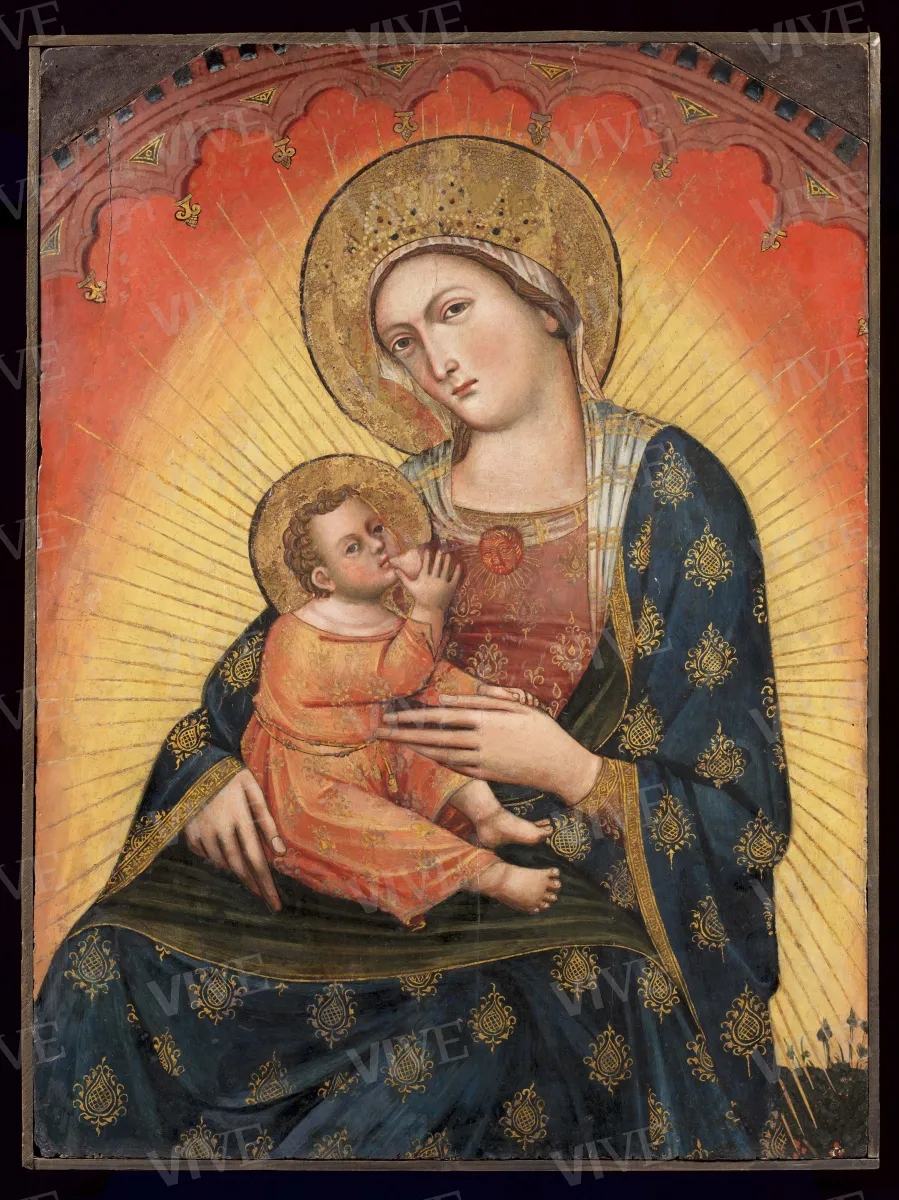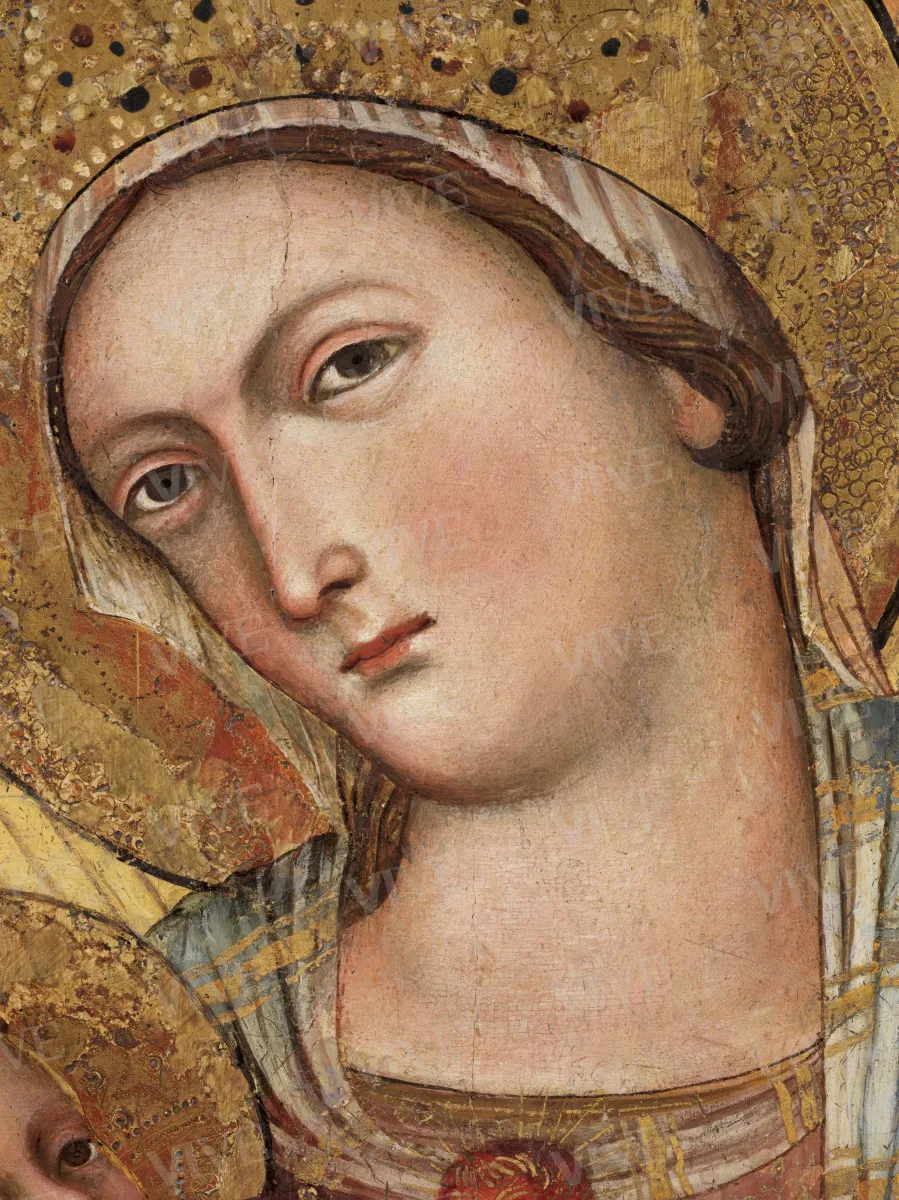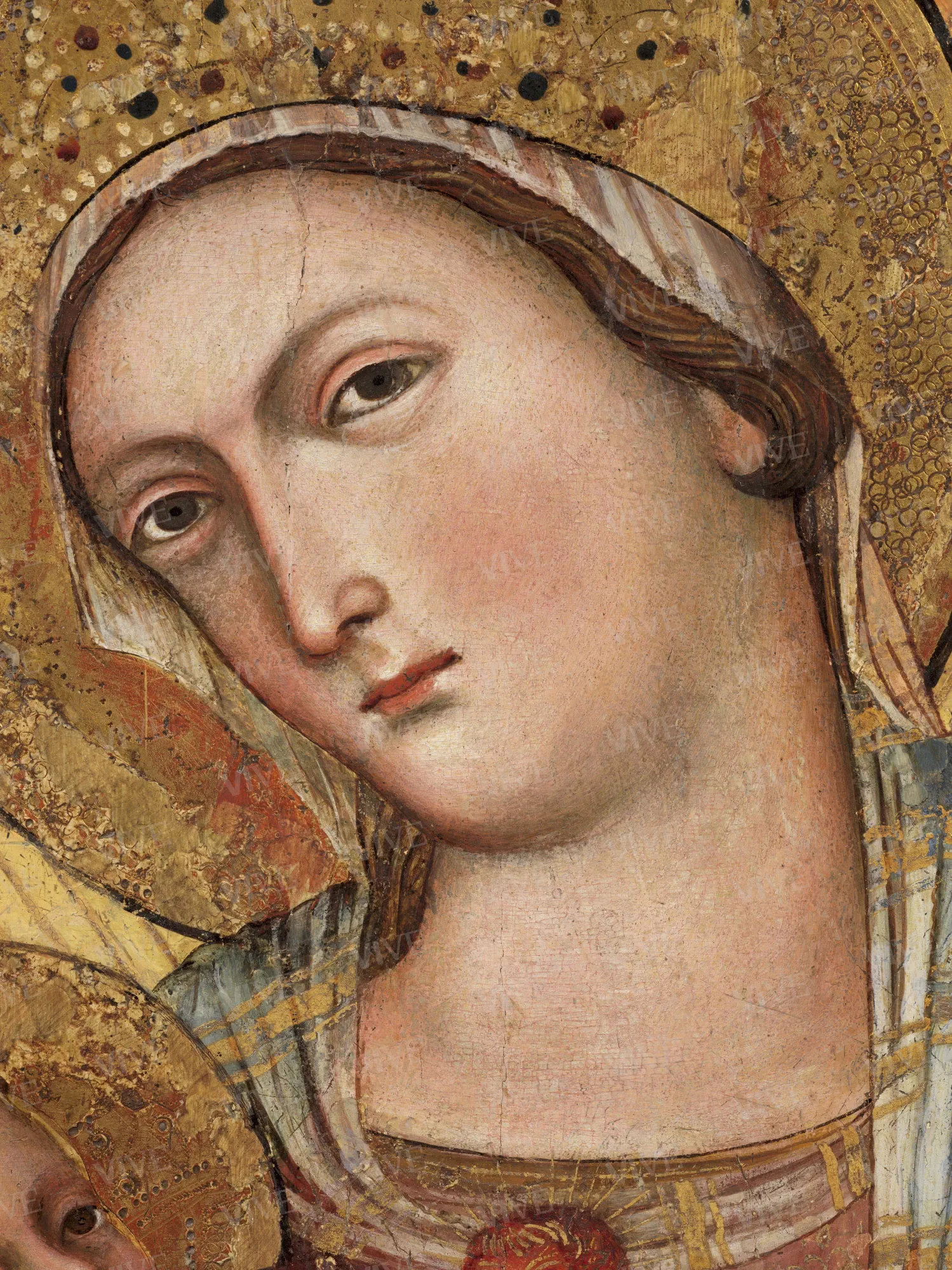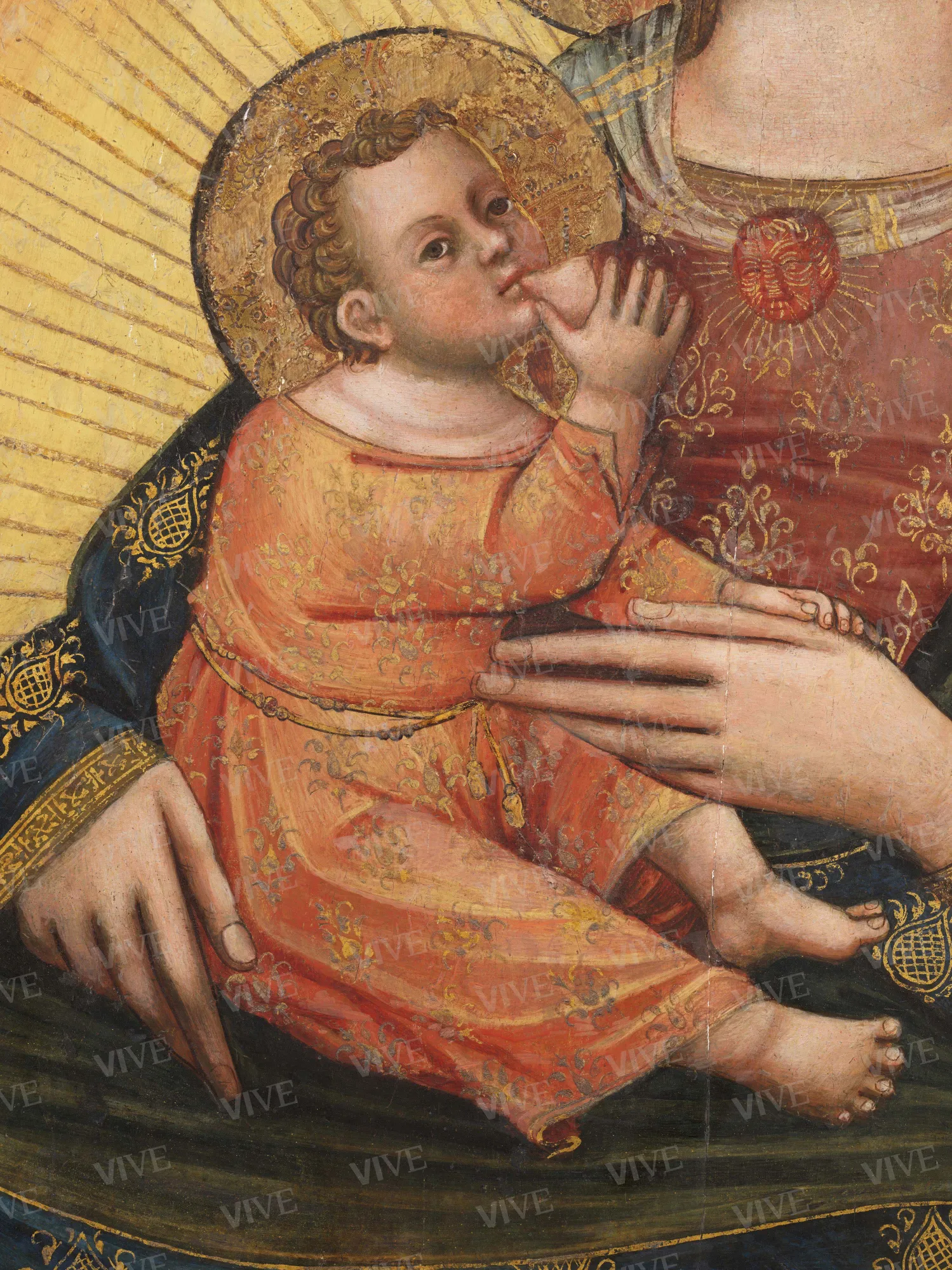Madonna and Child or Our Lady of Humility
Catarino Veneziano Late-14th century
The panel depicts a Madonna of Humility. The Virgin is sitting on the ground while hugging the Child. The panel has been cut out at the edges and is cropped below the Virgin’s knees. The figures stand out against a golden yellow background that fades to bright red, affording them luminosity and regality as they stand out from the background with plastic strength and forceful volume. The Virgin is wearing a light blue dress, which falls softly over her left shoulder, forming folds that give three-dimensionality to her body, and a red cloak with decorative elements in a darker shade.
The panel depicts a Madonna of Humility. The Virgin is sitting on the ground while hugging the Child. The panel has been cut out at the edges and is cropped below the Virgin’s knees. The figures stand out against a golden yellow background that fades to bright red, affording them luminosity and regality as they stand out from the background with plastic strength and forceful volume. The Virgin is wearing a light blue dress, which falls softly over her left shoulder, forming folds that give three-dimensionality to her body, and a red cloak with decorative elements in a darker shade.
Details of work
Catalog entry
The panel, depicting a Madonna and Child, has been cut out at the edges. Originally, it must have been larger and had a different shape than the present, and has possibly been cropped considering that at the upper edges of the panel the pictorial layer is cut off at an angle. The lower part has been somewhat tampered with, and the panel is, in fact, cut off just below the Virgin’s knees, making it difficult to work out the original position of the body. However, the lack of a visible seat or throne and the presence to the left of the figure of a swathe of dark earth from which the outlines of vegetal elements emerge, suggests that she is seated on the ground and that, in any case, she is placed in a bucolic context, and therefore is a Madonna of Humility (Flores D’Arcais 1979, pp. 385–287). The two main characters are contrasted with a golden yellow background that fades to bright red, which was not unusual in Venetian painters of the late fourteenth century and allowed them to confer luminosity and regality. The figures seem detached from the gold background thanks to their plastic force. The body of the Virgin is defined by a series of marked volumes, and is made all the more evident by the use of a slightly three-quarter pose. Her blue dress falls softly over her left shoulder, forming folds that give three-dimensionality to the body, especially in the area between the knees, thus demonstrating the artist’s skill in defining space. The harshness and rigidity found in other works by Catarino is almost entirely absent here, where the color transitions are smooth and the chiaroscuro well defined. The painting has rightly been compared by Francesca Flores D’Arcais with the Madonna of Humility by the same author held in the Pinacoteca Comunale in Faenza (Flores D’Arcais 1965, p. 144). Catarino made a rather substantial group of Madonnas of Humility, of which as many as five are known. In addition to the one in question, there is the Madonna of Humility in the central compartment of the Baltimore polyptych (Zeri 1976, pp. 55 ff.), another held in the Worcester Art Museum, another Madonna of Humility in the church of San Francesco della Vigna in Venice, and a fifth in the Pinacoteca Comunale in Faenza. It is difficult to list these chronologically as they repeat the same motif with minimal variations, similar to the manner of Lorenzo Veneziano and in keeping with the tired, lingering tradition of fourteenth-century Venetian painting. However, the dryness that is typical of Catarino’s pictorial production, alluded to earlier, is more evident in some of these works, such as in the Faenza Madonna, where the figures are defined by a sharp, marked outline and the Christ Child is given a less natural pose. The greater naturalness and skill in the depiction of the bodies’ movements found in the Madonna of Humility in Palazzo Venezia would lead one to hypothesize a later date for the panel in question, dating it to a phase of the artist’s full maturity. Virtually identical, on the other hand, are the Virgin’s pointed profile and absorbed expression, as well as the rendering of her tapering hands, which lends her a certain regality. The decoration with gilded elements of the Virgin’s blue cloak, on the other hand, is identical to that of the Baltimore polyptych. Mentioned by Cavalcaselle and Crowe in Storia della pittura in Italia (IV, 1887, pp. 319–324), by Venturi, by Testi—who has exhaustively solved, through the examination of the documentary sources found, the problem of the identification of Catarino with respect to two other homonymous artists active in Venice at almost the same time as him—and by Thieme-Becker (VI, p. 185), Catarino has been studied more thoroughly by other scholars along with his catalog as defined by Flores D’Arcais herself. Flores D’Arcais also drew interesting parallels between the artist’s manners and those of the better-known Lorenzo and Paolo Veneziano (Pallucchini 1964, p. 198), also assuming, however, a direct contact with other mainland painters, as is evident in Catarino’s habit of communicating volumes by means of chiaroscuro (Flores D’Arcais 1979).
We are, however, dealing with a secondary figure of late fourteenth-century Venetian painting, a “popularizer” of the manner of better-known and more talented artists working in Venice during more or less the same period.
Valentina Fraticelli
Entry published on 12 February 2025
State of conservation
Good.
Provenance
Collezione Lupi;
Collezione Giulio Sterbini;
Rome, Collezione Giovanni Armenise;
Rome, Museo Nazionale di Palazzo Venezia, 1940.
References
Cavalcaselle Giovanni Battista, Crowe Joseph Archer, Storia della pittura in Italia dal secolo II al secolo XVI, IV, London 1887, pp. 319-324;
Venturi Lionello, Le origini della pittura veneziana. 1300-1500, Venezia 1907, pp. 32-34;
Test Laudedeo, La storia della pittura veneziana, I, Bergamo 1909, pp. 236-246;
Il Museo di Palazzo Venezia. Catalogo. 1. Dipinti, Santangelo Antonino (a cura di), Roma 1948, p. 31;
Thieme Ulrich, Becker Felix, Kunstlerlexicon, VI, Frankfurt am Main 1921, p. 185;
Prijateli Kruno, Un documento zaratino su Catarino e Donato, in «Arte veneta», 16, 1962 (1963), pp. 145-146;
Pallucchini Rodolfo, La pittura veneziana del Trecento, Venezia-Roma 1964, pp. 195-200;
Scassellati Riccardi Vincenza, Una "Madonna" di Catarino, in «Arte antica e moderna», 27, 1964, pp. 295-296;
Dazzi Manlio Torquato, L'"Incoronazione della Vergine" di Donato e Catarino, in «Atti dell'Istituto veneto di scienze, lettere e arti, classe di scienze morali e lettere», 123, Venezia 1964-1965, pp. 515-525;
Flores D’Arcais Francesca, Per il catalogo di Catarino, in «Arte Veneta», 1965, p. 144;
Petricioli Ivo, Jedno Catarinovo dielo u Zadru? (Un'opera di Catarino a Zara?), in «Peristil», 7-9, 1965-1966, pp. 57-61;
Zeri Federico, Italian painting in the Walters Art Gallery, Baltimore 1976;
Flores D’Arcais Francesca, Catarino Veneziano, ad vocem, in Dizionario Biografico degli Italiani, 22, Roma 1979, pp. 385-387;
Lucco Mauro, Caterino di Marco da Venezia, in La pittura in Italia. Il Duecento e il Trecento a Venezia, Milano 1986, I, pp. 142-144; II, pp. 561-562;
Petrocchi Stefano, Caterino, ad vocem, in Enciclopedia dell'Arte medievale, Roma 2003.


















